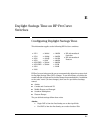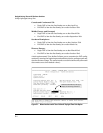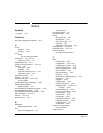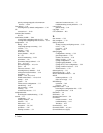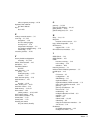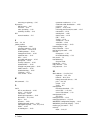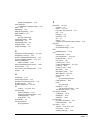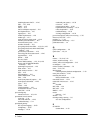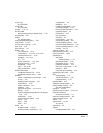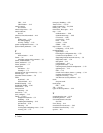
startup configuration … 3-10
menu interface
configuration changes, saving … 3-10
MIB … 13-4
MIB listing … 13-4
MIB, HP proprietary … 13-4
MIB, standard … 13-4
mirroring
See port monitoring.
monitoring traffic … B-24
multinetting … 8-9
multinetting, limit … 8-9
multiple VLAN … 13-3
multi-port bridge … 8-2
N
navigation, console interface … 3-9, 3-10
navigation, event log … C-25
network management functions … 13-5
network manager address … 13-4, 13-5
network monitoring
traffic overload … B-24
Network Monitoring Port screen … B-24
network slow … C-8
Not Current One, debug session … C-33
notices … 1-ii
O
online help … 5-13
online help location … 5-13
operation not allowed, LACP … C-11
operator access … 13-13
operator password … 5-8, 5-10
OS
version … A-5, A-12, A-15
OS download
failure indication … A-17
switch-to-switch download … A-14
troubleshooting … A-17
using TFTP … A-3
out-of-band … 2-4
over-temperature
See temperature
P
password … 5-8, 5-10
creating … 5-8
delete … 3-7, 5-11
if you lose the password … 5-11
lost … 5-11
manager … 5-8
operator … 5-8
set … 3-7
setting … 5-9
using to access browser and console … 5-10
ping test
description … C-35
for troubleshooting … C-35
PoE
disabling a port … 11-16
port
address table … B-14
auto negotiation … 10-4, 10-5
broadcast limit … 10-11
CLI access … 10-7
context level … 10-10
control configuration … 10-1, 12-1
counters … B-10
counters, reset … B-10
fiber-optic … 10-5
full-duplex, LACP … 10-5
MAC address … D-3, D-4
menu access … 10-6
queues
See port-based priority.
traffic patterns … B-10
trunk
See port trunk.
utilization … 5-16
web browser interface … 5-16
web browser access … 10-17
port names, friendly
configuring … 10-35
displaying … 10-37
summary … 10-34
port security
port trunk restriction … 12-4
trunk restriction … 12-9
port trunk … 12-2
caution … 12-5, 12-10, 12-17
CLI access … 12-12
default trunk type … 12-11
Index – 5



